London fire: Six questions for the investigation
 Getty Images
Getty ImagesA total of 80 people are feared dead after a huge fire engulfed the 24-storey Grenfell tower block in west London, destroying 151 homes. Several questions emerged for the investigation into the disaster, some of which have been answered.

1. How did the fire start?
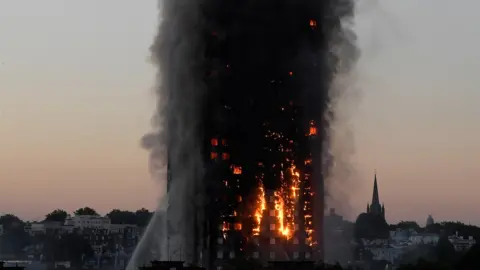 Reuters/Toby Melville
Reuters/Toby MelvilleFirefighters were called to Grenfell Tower at 00:54 BST on 14 June and the fire was brought under control at 01:14 BST the next day.
The fire started in a Hotpoint fridge freezer and the government ordered immediate testing of the appliance.
Police said the fire had not been started deliberately and the speed with which the fire spread was "unexpected".
Fridge freezers and other electrical appliances are a relatively common cause of fires.
Anyone who has a white Hotpoint fridge freezer model number FF175BP or graphite fridge freezer model number FF175BG should register their appliance with the manufacturer to receive any updates.
It is believed to have started on the fourth floor.
Tower blocks are designed so fires should stay contained within individual flats. But this clearly did not happen.
In 2009, three women and three children were killed by a fire in the 14-storey Lakanal House, in Camberwell, south-east London, which started in a TV set on the ninth floor.
Southwark Council admitted it had failed to address fire risks and was fined £270,000, plus £300,000 in costs.

2. Why did the fire spread so quickly?
Footage has shown the fire spreading up one side of the building externally, before engulfing the entire block.
Fire safety expert Elvin Edwards described it as a "chimney effect", adding that the wind would have fanned the flames.
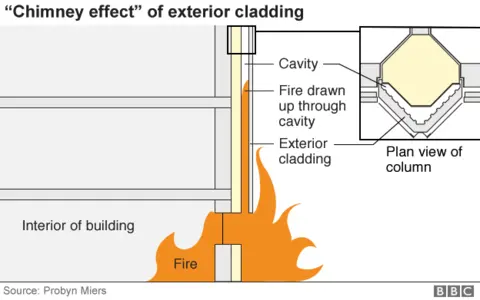
Cladding can create cavities which in some cases can cause a chimney effect, drawing flames up the cavity if there are no fire barriers.
It is unclear whether Grenfell Tower was fitted with fire barriers.
The London Fire Brigade's aerial platform vehicles can reach heights of only about 32m (105ft) - limiting how high up the blaze can be fought.
Having to get 20 storeys up to rescue people in that situation "is just unbelievable", firefighter turned safety consultant Bob Parkin said.
Matt Wrack, of the Fire Brigades Union, said something had clearly gone badly wrong with fire prevention procedures at the building.
Before and during a recent refurbishment, the local Grenfell Action Group said the block constituted a fire risk and residents warned that site access for emergency vehicles was "severely restricted".


3. Should there have been alarms and sprinklers?
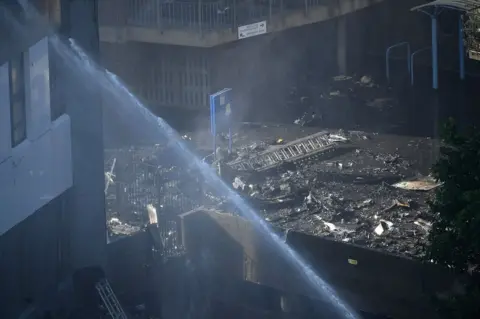 getty/Leon Neal
getty/Leon NealThe block - which was built in 1974 - did not have a sprinkler system.
Under current law, all new residential blocks over 30m high must have sprinkler systems fitted.
There is no legal requirement for local authorities to retrofit sprinklers to tower blocks.
Ronnie King, honorary secretary of the All-Party Fire Safety and Rescue Group, told LBC Radio there were about 4,000 tower blocks that did not have fire sprinklers fitted.
He said after the fire in Lakanal House there had been a "recommendation, which was down to each local council and landlords to determine the appropriateness" regarding fitting sprinklers in some blocks.
The coroner in the inquest into the fire also recommended that the government encouraged providers of high-rise buildings to consider the retrofitting of sprinkler systems.
In Wales, sprinklers are compulsory for all newly-built houses and blocks of flats, as well as care homes and university halls of residence.
Paul Fuller, chairman of the Fire Sector Federation, said sprinklers could have helped lessen the impact of the fire.
He told BBC Radio 4's World at One programme: "We know that sprinklers are effective.
"Also, sprinklers will make the environment more survivable by containing the fire and containing the smoke. But they are not a total solution."
The British Automatic Fire Sprinkler Association (BAFSA), the trade body for the fire sprinkler industry, said retrofitting the building with sprinklers might have cost £200,000.
Rydon Construction carried out the £8.6m refurbishment of Grenfell Tower, which was completed in May last year.
Kensington and Chelsea council leader Nick Paget-Brown said Grenfell Tower was not fitted with sprinklers during the refurbishment as the authority was told that fires in high-rises should be able to be contained within the flat of origin.
He told BBC Newsnight there was also not a "collective view" by residents to retrofit sprinklers in all flats as it would have delayed and caused further disruption to the upgrade.
Some residents have also reported not hearing fire alarms.
Alarms will often go off only on the floor affected, according to fire expert Elfyn Edwards.

4. Did a renovation in 2016 affect the building's safety?
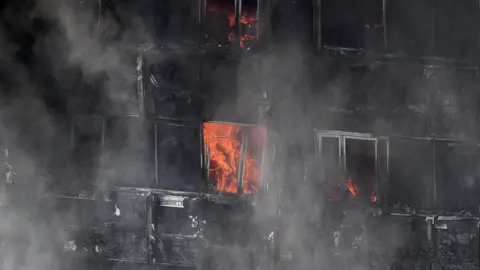 Getty Images
Getty ImagesRydon Construction, which carried out the refurbishment, said it had delivered a "number of improvements" to community facilities and energy efficiency to the building.
"Externally, rain screen cladding, curtain wall facade and replacement windows were fitted, improving thermal insulation and modernising the exterior of the building," it said.
Fire safety experts have pointed to cladding on the building as a possible reason the blaze spread so quickly externally.
The cladding requested for the refurbishment had a metal outer coating and an expanded foam interior.
It had a polyethylene - or plastic - core instead of an even more fireproof alternative, BBC Newsnight understands.
However, experts told the programme that cladding with a mineral core is considered to be less flammable.
The Times reported that the particular type of cladding used on Grenfell Tower is banned in the US on buildings taller than 40ft (12m) - for fire safety reasons.
It says the manufacturer makes two fire-resistant alternatives, but they are more expensive.
The paper calculates the difference in cost at Grenfell Tower would have amounted to less than £5,000 for the entire building.
The Department for Communities and Local Government said that if the cladding used was a composite aluminium panel with a polyethylene core, it would be non-compliant with current building regulations guidance.
This material should not be used as cladding on buildings over 18m high, the department said.
It would not comment on the type used at Grenfell. This would be subject to investigations into the fire's cause, it said.
Chancellor Philip Hammond told the BBC's Andrew Marr Show that there were two questions to be asked regarding cladding.
"One, are our regulations correct, do they permit the right kind of materials and ban the wrong kind of materials?" he said.
"The second question is were they correctly complied with? That will be a subject that the inquiry will look at."
Preliminary tests on samples of building insulation showed it burned soon after the test started, and more quickly than the cladding tiles.
They both failed the police's safety tests which are similar to those being carried out by the government.
The cladding, insulation, fixings and installation will be examined both individually and how they worked together.
Police said all criminal charges were being considered "from manslaughter onwards" including health and safety and fire offences.
Every company involved in the building and refurbishment of Grenfell Tower would also be looked at as part of the investigation, they said.

Were green targets to blame?
By Roger Harrabin, environment analyst
Cladding can be used to improve thermal insulation and energy efficiency within buildings.
Some commentators are now asking whether green energy targets are to blame for Grenfell Tower fire.
But campaigners for warm homes say the insulation policy is right - it's the implementation that's wrong.
That's because insulation has transformed the lives of hundreds of thousands of people in cold damp tower blocks.
Comfort has improved, health is better, bills are slashed. Carbon emissions are down.
In fact insulation needs to be massively extended as the government strives to reduce fuel poverty and curb carbon emissions.
But engineers will need to use insulation that's safe for tower blocks - and then prove to sceptical tenants that it is safe.

The Fire Protection Association (FPA), the UK's national fire safety organisation, says that when properly fitted - and with its polyethylene insulation expertly encapsulated - cladding should resist fire.
In Dubai, recent high-rise building fires, including at the 79-storey Torch tower in 2015, spread because of cladding, according to fire engineering consultancy Tenable Dubai.
Ray Bailey, managing director at Harley Facades Limited, which installed the cladding, has said: "At this time, we are not aware of any link between the fire and the exterior cladding to the tower."
Rydon said its work met "all required building regulations, as well as fire regulation and health and safety standards".
A newsletter from Rydon sent to residents after the refurbishment said that smoke detection systems had been "upgraded and extended".
Local authorities are required to ensure appropriate fire safety procedures are in place in council-run blocks.
Inside Housing - a magazine for the UK social housing sector - has reported that information released by Kensington and Chelsea Council under the Freedom of Information Act shows the most recent fire risk assessment on the tower was in December 2015.
Kensington and Chelsea Council leader Nick Paget-Brown said high-rise buildings were regularly inspected.

5. Was the advice to stay put correct?
 Getty Images
Getty ImagesResidents of tower blocks such as Grenfell Tower, whose flats are not affected by fire or smoke, are usually advised to stay in place.
Safety standards are meant to contain fires to the individual flat affected and keep stairwells and hallways free of smoke for some time, says Graham Fieldhouse, allowing the fire to be fought and evacuations carefully managed.
"[Firefighters] don't need hundreds of people coming down the stairs when they are trying to fight the fire," the fire safety expert told the BBC.
Geoff Wilkinson, a fire and building inspector, told the BBC that one of his "major concerns" was that smoke seemed to have spread into escape routes.
A number of witnesses have told the BBC that hours after the fire first broke out, residents were still being told to stay in their flats and await for the fire service.

6. How will other buildings be affected?
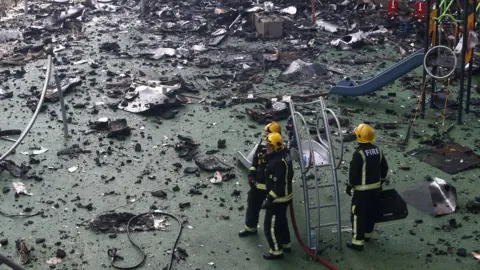 Reuters
ReutersA nationwide operation to identify buildings with cladding like that used in Grenfell Tower has seen local authorities urgently assessing their tower blocks for fire safety.
Councils have been sending in samples of cladding used in their high-rise blocks to see if they are dangerous.
They are trying to establish whether any materials used are the same as or similar to those thought to have caused the Grenfell fire.
In total, 259 high-rise blocks have now been found with cladding that raises concerns.
In Camden in north London, residents have been evacuated from four tower blocks over fire safety concerns.
The Communities Secretary, Sajid Javid, has also said safety checks are also urgently needed in hospitals, offices and private buildings and said NHS England was in contact with around 200 health trusts to check cladding on hospitals.
